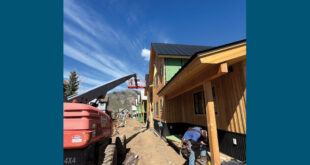Times are changing
By Kendra Walker
Representatives from Waste Management met with the Mt. Crested Butte Town Council during their February 4 meeting to discuss recycling in the valley.
Waste Management’s Grand Junction Material Recovery Facility processes 900 to 1,100 tons per month, according to Ken Stevens, manager of the Grand Junction facility. In 2019, the facility processed 278 tons from Crested Butte and Mt. Crested Butte. Waste Management’s recycling service in our end of the valley includes aluminum, tin, glass, plastics #1 through #7, newspaper/magazines, office paper and cardboard.
Currently, Waste Management takes plastics #1 through 7; however, they don’t have a market for those at present. But, explained Stevens, Waste Management is holding on to those plastics in hopes that markets will open up.
“Ultimately, whatever we collect and whatever the manufacturers make, it’s consumer-driven,” he said. “I think we’re going to see those markets develop or those packages will go away.”
Public sector solutions manager Ellie Reynolds explained Waste Management is still dedicated to recycling and finding those markets.
Note that the Gunnison Public Works Department only takes Plastics #1 and #2, so if your recyclables are collected by the city of Gunnison or you drop off your recyclables at the Gunnison County Recycle Center, they do not take plastics #3 to #7.
Reynolds also explained the importance of low contamination—the lower the contamination in the items Waste Management receives, the more cost effective, as markets are lowering the amount of contamination they can take. Waste Management facilities are doing what they can to take care of contamination, with new equipment that makes it fast and easier to sort; however, they still encourage folks to reduce the contamination on the recyclables as much as possible prior to throwing out.
Though he wasn’t present at the meeting, council member Roman Kolodziej had a recent complaint with Waste Management, and his fellow council members brought this to light during their discussion with the team. Doing his due diligence to shred documents and bag the shredded paper in clear bags for recycling pick-up (which he was told was the correct process by Waste Management), Kolodziej discovered his bags ended up in the trash anyway.
“We can take shredded paper. It’s the only thing that we have bagged,” responded Stevens. “It could have been accidentally thrown out.”
Without Kolodziej present to dive deeper, the discussion moved on.
The Waste Management team also clarified the confusion that certain recycled products cause in the recycling world. For example, disposable coffee cups are made from recycled paper but a plastic coating has been added to the material so it doesn’t break down when wet. “These products can’t be recycled, but they’re coming from recycled material,” said Reynolds, so those have to go in the trash.
This touched on the difficulties, regulations and frustrations in today’s world of recycling. “At the very peak of the recycling market, it was ‘We want everything, give us everything you possibly can,’” said Reynolds. “But now we want to be honest, times are changing,” she said, as more and more manufacturers are opting for cheaper materials than recyclables. The expression is no longer “When in doubt, throw it in,” she explained. Now, it’s “When in doubt, throw it out.”
But the Waste Management team reiterated the difference we can make if we continue to recycle, educate ourselves and educate future generations. “I really believe that’s where our future lies,” said Stevens. “Recycling only works if it’s a consolidated effort.”
 The Crested Butte News Serving the Gunnison Valley since 1999
The Crested Butte News Serving the Gunnison Valley since 1999


